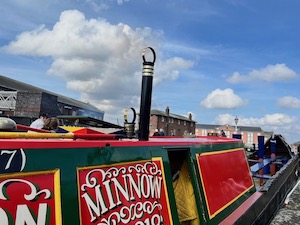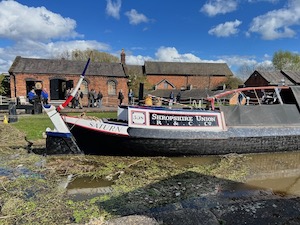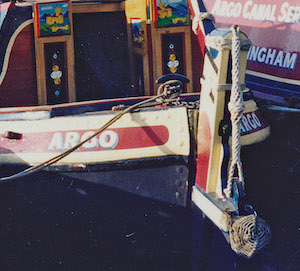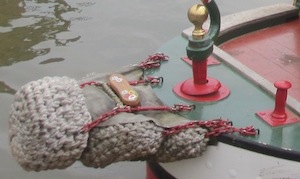< back to Know Your Boats
Introduction to Boat equipment and fittings
One of the aims of HNBC is to promote and campaign for the retention and/or reinstatement of appropriate traditional and historical waterway furniture, features and working practices and the words associated with the boats matter and are worth recording. Of course, language changes and evolves, and modern leisure boats may well introduce new terms, but for the boats listed on this website the usual names for various items are explained here, together with a note of terms that are sometimes mis-applied.
All photographs in this section are by R Prettyman, HNBC Web Content Editor, unless otherwise attributed.
Many of the items listed here are removable and will be tidied away in lockers or the cabin when the boat is not working
 |
Lines Straps |
A variety of ropes is used, with a variety of specialist names - lines and straps are general purpose ropes; snubbers and snatchers are for towing a loaded boat; cross straps are for towing an empty boat; strings are generally lighter ropes used for tying things down or for decoration. Thumb-lining and long-lining are rope techniques used when working through locks All working ropes are kept neatly on the deck lid or the cabin slide when not in use - never hung from the tiller pin or left as a trip hazard on the dollies |
||
 |
White strings Rockets |
Cotton lines secure the cloths covering the cratch. A length of fire hose, scrubbed white and secured with springs, is used to secure the leading edge over the deck board Rockets are the coiled ends of white strings |
||
 |
Shaft |
Long, rounded ash pole for moving boats, seen here on the covered hold of a tar boat Not used: 'boat hook', 'barge pole' |
||
 |
Keb |
Long handled rake with long tines, used for clearing away underwater obstructions |
||
 |
Cabin strings |
White strings, they hang from the chimney-pipe side of the cabin |
||
 |
Tall pipe Titch Cutter |
Tall exhaust pipe, to carry engine exhaust fumes away over the steerer's head The titch is a short exhaust pipe, used for tunnels and canals with low bridges A cutter is a hoop of brass at the top of either the tall pipe or the titch to break the force of the exhaust - aligned fore-and-aft |
||
 |
Water can |
For storage of drinking water - the carrying handle is placed forward over the lid of the pouring spout to keep debris out of the water [Photo: Kev Maslin] Rarely used: It is only called a 'Buckby can' if its provenance is from the shop in Buckby
|
||
 |
Mop Cabin shaft |
Placed on the cabin top, within reach of the steerer are: The long handled mop is often, but not necessarily, propped on the handle of the water can and is long enough to reach the canal when standing on the cabin top The cabin shaft is a short, rounded, ash pole (often with a hook) useful for clearing rubbish from the blades Not used: 'boat hook', 'barge pole' |
||
 |
Chimney Chimney chain |
Usually painted black, often with brass bands, it takes the range fumes away from the steerer and often has an extra insert to extend its height There is usually a decorative brass chain to secure the chimney to the cabin top |
||
 |
Tiller arm (horse boat or butty) |
A stout, shaped, wooden arm inserted into the ram's head, turned to the upright position or placed on the cabin top to signal being tied up (and for easier access to the hatches) When on the move, the tiller arm is turned to its downward position to move the rudder for steering It is dangerous to stand within the arc of the tiller which can sweep around with alarming speed and force if the rudder catches on an underwater obstruction. The safe place from which to steer is on the footboard within the entrance to the cabin |
||
 |
Tiller arm/bar (motor) |
A sturdy metal tube fitted to the ram's head/swan's neck for steering - a plain or painted one for bad weather, a polished brass one for when the sun shines Removed and stored inside the boat when tied up for ease of access to the cabin On the move, it is very dangerous to stand within the arc of the tiller which can sweep around with alarming speed and force if the rudder catches on an underwater obstruction, at best the unwary steerer gets a soaking, at worst broken bones or injury from the blades underneath. The safe place from which to steer is not the counter, but the footboard within the entrance to the cabin |
||
 |
Tiller pin |
Metal peg, often brass, secures the tiller arm/bar |
||
 |
Handbowl |
Flat bottomed pan with a short handle, used for washing, historically it was often called a dipper but this term has since been appropriated to describe a corn scoop (see photo below) This is a vintage example on exhibition at the National Waterways Museum, Ellesmere Port |
||
 |
Dipper |
Originally a corn scoop, it appeared as decorative painted gift ware in the 1960s A round bottomed pan with a short handle, it is now sometimes added to a boat's equipment and is seen here, left, placed upside down on the fenders to dry |
||
|
|
Fender |
A cushion-like device, usually made of rope, to protect a vessel from impact damage Fore end fender Usually a button, it is fastened on with chains which should have a sacrificial link within them - this breaks when under severe strain so that the boat is not hung up (eg on a lock gate) by its fender [Photo: Richard Booth]
|
||
|
|
Stern fenders Motor boats - a variety of configurations is used (eg three tipcats; two tipcats plus a button; one tipcat and two buttons) but there are always enough of them to extend beyond the rudder to protect it. Some boaters would fit a small piece of canvas or tarpaulin over the top of the tipcats, to stop muck getting into the knotting Stern fenders should not droop!
|
|||
|
The button or bumper in this photo is a rare example, called a 'London Fender', it looks like a coil of rope [Photo: Eric McDowall] |
||||
 |
Butty boats - seen here is a rudder fender with a spider-web pattern [Photo: Paul Monahan] |


